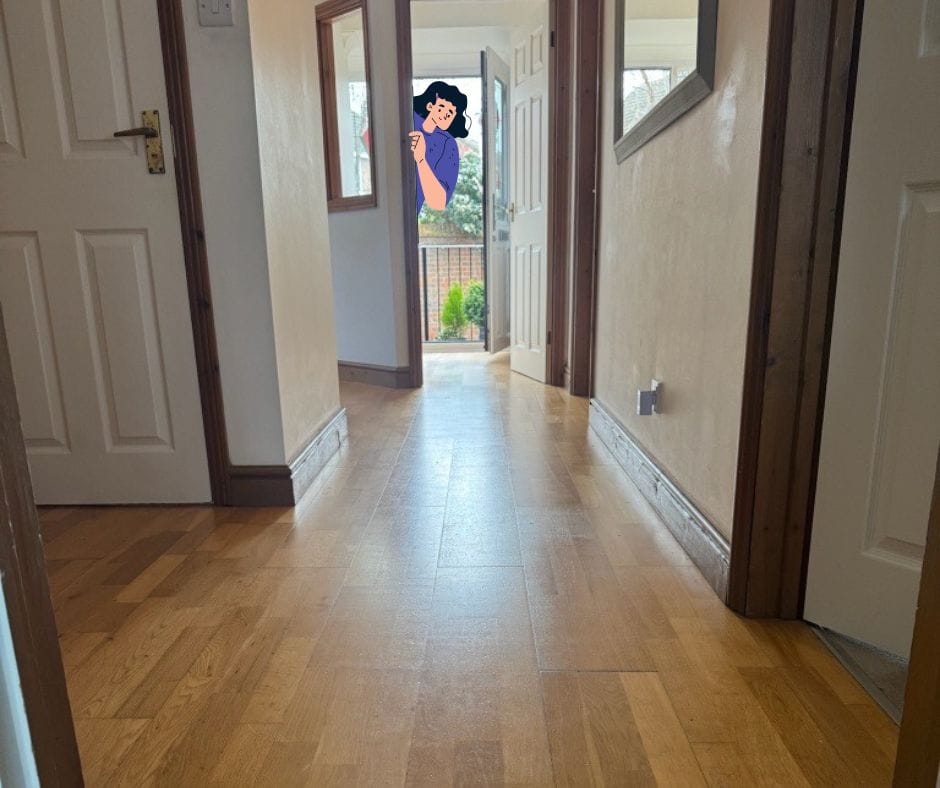When the charm and warmth of wooden flooring begin to fade under the marks of time and foot traffic, homeowners usually face the pivotal question: “Can my wooden floor endure another round of sanding?” The internet provides advice on this topic, but misinformation is rampant, leading to costly mistakes. Let’s delve into the facts, debunk myths, and arm you with the knowledge you need to decide to revive your wood floors.
Debunking Common Myths
One widespread myth is that a solid ¾-inch wood floor can sustain up to 12 or 13 sandings. This is misleading. The actual wear layer of such a floor is typically only about ¼ inch (6.35 mm) thick. Over-sanding can expose and damage the fasteners (like nails or staples) that keep your flooring secure, potentially ruining it. It’s crucial to approach the idea of sanding with a mix of scepticism towards general claims and an understanding of the specifics of your flooring.
Solid Wood Floors: A Delicate Balance
Sanding solid wood floors is a complex task. It’s an intricate process influenced by several critical factors:
- Professional Expertise: The success of sanding depends mainly on the craftsman’s skill. A seasoned professional can assess the floor’s condition and precisely execute the job.
- Equipment Quality: The machinery used for sanding matters immensely. For example, a multi-head sander can provide a more even and gentle sanding compared to traditional equipment, minimizing the risk of damage.
- Floor Flatness: A floor that isn’t flat can lead to uneven sanding. Peaks and valleys on the surface increase the risk of sanding through the wear layer and hitting the fasteners. If your floor is relatively flat and retains at least 3 mm (about 1/8 inch) of the wear layer, it’s generally safe to sand.
- Finish Type: The choice of finish post-sanding is another critical consideration. Water-based finishes might react with the wood, causing curling at the edges. In such cases, oil-modified or solvent-based finishes could be preferable.
Engineered Wood Floors: Proceed with Caution
Engineered wood floors demand an even more cautious approach:
- Wear Layer Assessment: Before sanding, it’s essential to check the thickness of the wear layer. A layer of 3 mm or more is ideal, but even floors an expert can sand 2 mm layer under the right conditions.
- Bevelled Edges: Sanding will modify the bevelled edges of planks if not completely removed. The professional should discuss this effect with homeowners beforehand to set realistic expectations.
- Equipment Considerations: A multi-head sander is recommended for engineered floors, especially those with a thin wear layer (2 to 3 mm), to avoid aggressive removal of the surface.
Beyond the Surface: Other Factors to Consider
- Finish Removal: The existing finish on your floor (e.g., aluminium oxide or ceramic coatings) can complicate the sanding process. These finishes are tough and require a nuanced approach to remove without causing damage.
- Gradual Approach: Adopting a methodical, gradual process is vital. Jumping to aggressive grits can do more harm than good. It’s akin to eating an elephant—one bite at a time. Patience and precision are your best tools.
The Verdict
Deciding whether to sand your wooden floor again is an important decision that requires a careful assessment of the floor’s current condition, an understanding of the risks involved, and the expertise of the professionals you choose to hire. The key lies in the details with solid wood or engineered floors—such as the wear layer’s thickness, the equipment used, and the finish applied afterwards.
Remember, each floor is unique, and so is each sanding scenario. By considering everything above, you can make an informed decision that ensures the longevity & beauty of your wooden floors. Whether you’re looking to refresh the look of your home or restore the splendour of worn flooring, understanding the nuances of sanding is the first step towards achieving those goals.
FAQs on the topic of sanding wooden floors:
1. How do I know if my wooden floor has enough wear layer left for another sanding?
To determine if there’s enough wear layer left for sanding, you need to measure the thickness of the top layer of wood that nails or fasteners have not penetrated. For solid wood floors, ensure there’s at least 3 mm (about 1/8 inch) of the wear layer remaining. For engineered wood floors, a wear layer of at least 2 mm is necessary for sanding, though more is preferable. Using a professional service to assess your floor can provide more accurate measurements and advice.
2. Can engineered wood floors be sanded & refinished like solid wood floors?
Yes, engineered wood floors can be sanded and refinished, but there are limitations compared to solid wood. The key factor is the thickness of the wear layer. You can sand-engineered floors with a wear layer of at least 2 mm, but floors with 3 mm or more are better candidates. The process requires skilled professionals to avoid damaging the floor, especially since engineered wood cannot withstand as many sandings as solid wood.
3. What are the risks of sanding a wooden floor?
Sanding a wooden floor comes with several risks if not done correctly, including:
- Sanding too deep and hitting the nails or staples can damage the floor and tools.
- Removing too much of the wear layer, weakening the floor’s structure.
- Causing uneven surfaces by sanding more in some areas than others, especially on floors that aren’t flat.
- Applying the wrong type of finish after sanding can lead to issues like wood curling at the edges.
If you want to reduce these risks, using skilled professionals and quality equipment is important.
4. How often can a wooden floor be sanded?
The frequency at which you can sand a wooden floor depends on several factors, including the type of wood, the thickness of the wear layer, and how much of the material you remove with each sanding. Solid wood floors can typically be sanded more times than engineered wood floors due to their thicker wear layer. A general guideline is that a solid wood floor with a ¾-inch thickness can be sanded every 10-20 years, depending on wear and damage, for a total of 3-6 times over its lifespan. Engineered floors have a more limited capacity for sanding, usually only 1-3 times, depending on the thickness of the wear layer.

Written by Tracey Gilbey, Marketing
For further advice or information on our Carpet and Soft Furnishing care, please don’t hesitate to contact the Art of Clean team on 01223 901549 in Cambridge. Our services include Carpet Cleaning, Upholstery Cleaning, oriental and area Rug Cleaning. Curtain Cleaning, Patio and Driveway Pressure washing, Leather Cleaning, Stone and Tile Floor Cleaning and Wood Floor Sanding and Restoration. We also supply new flooring and carpets through our sister company Art of Flooring. Farthings Cambridge provides our Dry Cleaning service.

